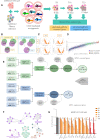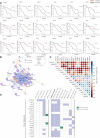KAP1 is a new non-genetic vulnerability of malignant pleural mesothelioma (MPM)
- PMID: 35910692
- PMCID: PMC9336180
- DOI: 10.1093/narcan/zcac024
KAP1 is a new non-genetic vulnerability of malignant pleural mesothelioma (MPM)
Abstract
Malignant pleural mesothelioma (MPM) is a rare and incurable cancer, which incidence is increasing in many countries. MPM escapes the classical genetic model of cancer evolution, lacking a distinctive genetic fingerprint. Omics profiling revealed extensive heterogeneity failing to identify major vulnerabilities and restraining development of MPM-oriented therapies. Here, we performed a multilayered analysis based on a functional genome-wide CRISPR/Cas9 screening integrated with patients molecular and clinical data, to identify new non-genetic vulnerabilities of MPM. We identified a core of 18 functionally-related genes as essential for MPM cells. The chromatin reader KAP1 emerged as a dependency of MPM. We showed that KAP1 supports cell growth by orchestrating the expression of a G2/M-specific program, ensuring mitosis correct execution. Targeting KAP1 transcriptional function, by using CDK9 inhibitors resulted in a dramatic loss of MPM cells viability and shutdown of the KAP1-mediated program. Validation analysis on two independent MPM-patients sets, including a consecutive, retrospective cohort of 97 MPM, confirmed KAP1 as new non-genetic dependency of MPM and proved the association of its dependent gene program with reduced patients' survival probability. Overall these data: provided new insights into the biology of MPM delineating KAP1 and its target genes as building blocks of its clinical aggressiveness.
© The Author(s) 2022. Published by Oxford University Press on behalf of NAR Cancer.
Figures







Similar articles
-
Therapeutic Landscape of Malignant Pleural Mesothelioma: Collateral Vulnerabilities and Evolutionary Dependencies in the Spotlight.Front Oncol. 2020 Sep 23;10:579464. doi: 10.3389/fonc.2020.579464. eCollection 2020. Front Oncol. 2020. PMID: 33072611 Free PMC article. Review.
-
Malignant pleural mesothelioma and mesothelial hyperplasia: A new molecular tool for the differential diagnosis.Oncotarget. 2017 Jan 10;8(2):2758-2770. doi: 10.18632/oncotarget.13174. Oncotarget. 2017. PMID: 27835874 Free PMC article.
-
Genomics and Functional Genomics of Malignant Pleural Mesothelioma.Int J Mol Sci. 2020 Sep 1;21(17):6342. doi: 10.3390/ijms21176342. Int J Mol Sci. 2020. PMID: 32882916 Free PMC article. Review.
-
Endoplasmic Reticulum Stress Signaling as a Therapeutic Target in Malignant Pleural Mesothelioma.Cancers (Basel). 2019 Oct 8;11(10):1502. doi: 10.3390/cancers11101502. Cancers (Basel). 2019. PMID: 31597321 Free PMC article.
-
Molecular Fingerprints of Malignant Pleural Mesothelioma: Not Just a Matter of Genetic Alterations.J Clin Med. 2021 Jun 2;10(11):2470. doi: 10.3390/jcm10112470. J Clin Med. 2021. PMID: 34199544 Free PMC article. Review.
Cited by
-
Exploring the Expression of the «Dark Matter» of the Genome in Mesothelioma for Potentially Predictive Biomarkers for Prognosis and Immunotherapy.Cancers (Basel). 2023 May 29;15(11):2969. doi: 10.3390/cancers15112969. Cancers (Basel). 2023. PMID: 37296931 Free PMC article. Review.
-
Genome-wide CRISPR screen identifies BUB1 kinase as a druggable vulnerability in malignant pleural mesothelioma.Cell Death Dis. 2025 Apr 3;16(1):241. doi: 10.1038/s41419-025-07587-z. Cell Death Dis. 2025. PMID: 40180891 Free PMC article.
References
-
- Galateau-Salle F., Churg A., Roggli V., Travis W.D.World Health Organization Committee for Tumors of the Pleura The 2015 World Health Organization classification of tumors of the pleura: advances since the 2004 classification. J. Thorac. Oncol. 2016; 11:142–154. - PubMed
-
- Bianchi C., Bianchi T. Malignant mesothelioma: global incidence and relationship with asbestos. Ind. Health. 2007; 45:379–387. - PubMed
-
- Lococo F., Torricelli F., Lang-Lazdunski L., Veronesi G., Rena O., Paci M., Casadio C., Piana S., Novellis P., Di Stefano T.S. et al. . Survival results in biphasic malignant pleural mesothelioma patients: a multicentric analysis. J. Thorac. Cardiovasc. Surg. 2020; 159:1584–1593. - PubMed
-
- Yap T.A., Aerts J.G., Popat S., Fennell D.A. Novel insights into mesothelioma biology and implications for therapy. Nat. Rev. Cancer. 2017; 17:475–488. - PubMed
LinkOut - more resources
Full Text Sources
Molecular Biology Databases
Research Materials
Miscellaneous

